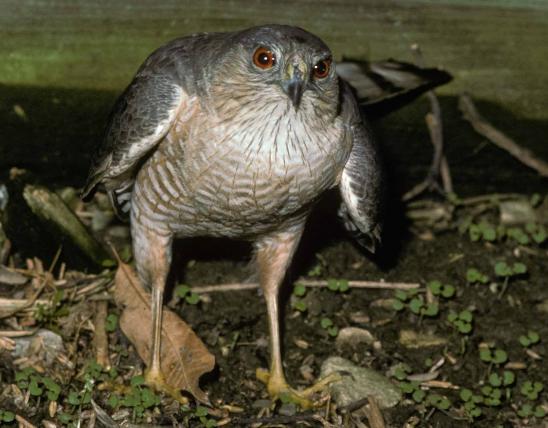
American kestrels are the smallest and the most colorful North American falcon. Both males and females have gray on their heads and two black stripes on white cheeks. Adult males have bluish-gray wings; females have brownish wings. Back and tail are orange-brown, the male with a dark band near the end of the tail and the female with many dark bars. Breast is whitish to pale orange in males and streaked in females and immatures. Immature male has a streaked breast and a completely barred back. Immature female is difficult to distinguish from adult female. Voice is a loud, shrill, “killy, killy, killy.”
Length: 9–11 inches (tip of bill to tip of tail); wingspan: 20–23 inches.

Statewide.
Habitat and Conservation
Kestrels are birds of open country, grasslands, farmland, and suburban and urban areas. They are the only falcon or hawk on this continent to nest in cavities. Because many old-growth trees and snags are being cut or cleared, and with the conversion of habitat to monotypic grain farms, these beautiful falcons have declined in some areas.
You can help kestrels by setting up a special nest box for them. Information about nest boxes can be found on the American Kestrel Partnership website.
Food
Kestrels typically hunt from a conspicuous perch or hover like miniature helicopters. The flight is buoyant, graceful, and rapid, like a large swallow. They eat mostly insects and other invertebrates as well as small rodents, small birds, and small reptiles. Common foods include grasshoppers, cicadas, dragonflies, spiders, butterflies, bats, voles, mice, and small songbirds.
Status
Common migrant; common winter resident in southern Missouri; uncommon summer resident statewide.
Life Cycle
Kestrels nest in cavities in trees. Nesting usually begins in mid-March, and a clutch of 4–6 eggs is laid in early April. The female does most of the incubating for 28–30 days, while the male hunts for her. Young kestrels fledge from the nest after 28–30 days.
Human Connections
These small raptors are favorites of birders because of their graceful flight and attractive plumage. Many Missourians have built and installed nesting boxes so they can watch kestrels raise and feed families.
Ecosystem Connections
This efficient raptor hunts small prey and helps keep populations of those prey species in check. Kestrels, in turn, may be eaten by larger raptors, and their eggs and nestlings may be eaten by snakes.







About 350 species of birds are likely to be seen in Missouri, though nearly 400 have been recorded within our borders. Most people know a bird when they see one — it has feathers, wings, and a bill. Birds are warm-blooded, and most species can fly. Many migrate hundreds or thousands of miles. Birds lay hard-shelled eggs (often in a nest), and the parents care for the young. Many communicate with songs and calls.


























